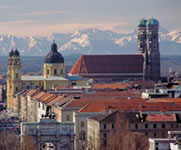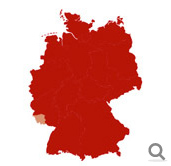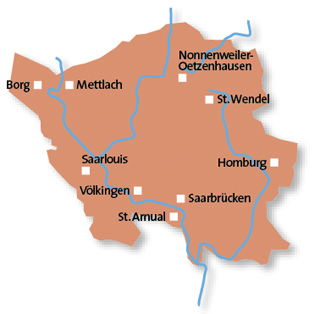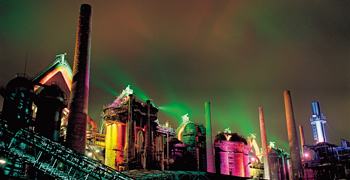
Historical Towns
- Historical towns in Brandenburg
- Cathedral Towns and Cities in Saxony-Anhalt
- The innovative Anhalt-Wittenberg Region
- Enchanting towns in the Harz
- The beautiful towns and cities in Saxony
- Towns and cities of culture in Thuringia
- Beautiful towns of Franconia
- East Bavarian traditional towns
- Alpine towns in the Allg�u
- The eastern Akpine Foothills and their towns
- Towns and villages in the western foothills of the Alps
- Mediterranean towns on Lake Constance
- Towns in the Swabian Alb
- Unspoilt towns in the Black Forest
- Towns for refined tastes in the Heilbronner Land
- Towns in the Odenwald
- Wine towns in Rheinhessen
- Saarland, a region of contrasts
- Romantic towns in the Hunsr�ck and Nahe Regions
- Idyllic towns and villages in the Moselle Region
- The Ahr Rhine Eifel holiday region
- Wine towns on the Romantic Rhine
- Modern towns and cities in the Bergisches Land Region
- The Lahn Valley and its fairytale towns
- Historical towns in Kurhessisches Bergland
- Sauerland's scenic towns
- Fairytale towns in the Weserbergland Hills
- Majestic towns in the M�nsterland Region
- The nine stars of Lower Saxony
- North and East Frisian Islands
- Vibrant Schleswig-Holstein
- Maritime towns along Mecklenburg's Baltic Coast
- Historical Hanseatic Towns
- Germany's Baltic Sea Islands
- The Mecklenburg Lakes
Contact and information
Industrial heritage, French joie de vivre and the famous bow in the Saar river

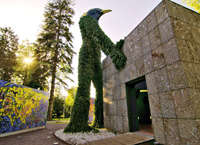
Saarland towns
Saarlouis has a long history as a garrison town. The Bourbon lilies on its coat of arms as well as many of its architectural features can be traced back to the town's founder, Louis XIV of France, known as the Sun King. His architect, Sébastien Le Prestre de Vauban, designed the town to protect France's eastern border. The fortifications in the idyllic Saar Altarm recreation area and the historical casemates are just two examples of its mixed heritage.Mettlach is home to Villeroy & Boch, one of the most renowned manufacturers of exclusive porcelain, and a company more than 250 years old that has been in family ownership for virtually all its history. The visitor centre incorporates a ceramics museum and special exhibitions. Other attractions in Mettlach include the Old Tower, thought to be the oldest religious building in the Saarland, and the former Benedictine Abbey founded in the 18th century.
Saarbrücken
The picturesque narrow streets, secluded courtyards and bijou bistros of Saarbrücken, the regional capital, are evidence of its proximity to France. St. Johanner Markt square, the palace with its avant garde centrepiece and Ludwigskirche church are well worth a visit. The latter is the main feature of the town's place royale architecture and it is regarded as one of the purest examples of a Protestant baroque church in Germany.Schwarzenacker Open-Air Museum, Homburg
The archaeological finds unearthed in and around Schwarzenacker near Homburg include the remains of a sudatorium, a hoard of coins, burial grounds and stone statues. They are not only of vast scientific value, they are primarily tangible evidence of presentday Saarland's Gallo-Roman past. In the first century BC, Saarland was part of Gaul, which was conquered by Julius Caesar and incorporated into the Roman Empire. The Roman museum illustrates Roman domestic life as it was 2,000 years ago.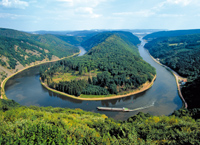
Saar Bow
The Saar river has always been the lifeblood of the region. It winds its way through the countryside, meandering around gently rolling hills and fissured rock faces. Between Merzig and Saarburg the river has cut deep into the quartzite hills and near Mettlach it has created the Saar Bow, one of the most awe-inspiring geological features in the Saarland. The best view of this magnificent river bend is from the Cloef viewing point in Orscholz, close to Mettlach. Countless cycle routes criss-cross the Saarland and walkers can choose from 40 premium trails in the region.Völklingen Ironworks
In Völklingen the iron age lasted nearly a hundred years. The first blast furnace was fired up in this former industrial town in 1883, and the last was closed down in 1986. Today, Völklingen Ironworks is a fascinating industrial monument and a UNESCO World Heritage site. Six furnaces on a 250-metre long axis form the centre, then there are the vast halls, the coking plant, conveyor belts, lifts and giant blowers which used to blast hot air onto the melted iron, making it glow white.Land of the Lyoner sausage
The Lyoner is a revered delicacy a typically German-style sausage that tastes best in the Saarland, close to the border with France. Visitors to the region should also sample the Saarland signature dish of schwenker marinated meat grilled over a beechwood fire. Other firm favourites include potato specialities such as dibbelabbes (grated potato, dried meat and leek, stewed in a pot and served with apple sauce) and gefillde (potato dumplings filled with mince and liver paté). Nowhere else in Germany will you find anything like verheiratete, dumplings with potatoes in a creamy ham sauce. The French influence also shines through in the dishes on offer at the region's cosy bistros, brasseries and top restaurants.Travel Planner
Select an option...
Romance and charm
The Offizierspfad premium walking trail one of the finest in the Saarland winds between broad swathes of woodland and has magnificent views of the St. Wendeler Land region. The trail starts and ends at the Hofgut Imsbach hotel, idyllically located in a country park.
Food and drink
The Viezstrasse Route du Cidre runs for over 150km from Überherrn to the confluence of the Saar and Moselle rivers taking in orchards and apple-related places of interest in the Saarland's apple-growing region.
History and tradition
The Reden Garden, a former industrial site, is centred around a disused coal mine, all that is left of a great industrial past, and the Gondwana interactive museum, the Saarland's new, prehistoric attraction.
Nature and scenery
The Bliesgau UNESCO biosphere reserve is in south-eastern Saarland. The region is a patchwork of orchards, beech woods and meadows along the Blies river, heaven for cyclists and walkers. A guided walk to see orchids growing in the wild is not to be missed.
 Skip to content
Skip to navigation
Skip to subnavigation
Skip to search
Skip to content
Skip to navigation
Skip to subnavigation
Skip to search




